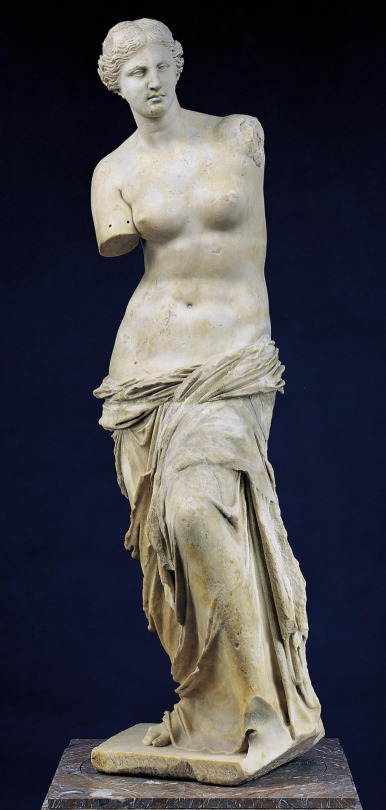
Alexandros of Antioch, Venus de Milo, 150-125 BCE
We’re pleased to present a series of excerpts from Jane Ursula Harris’ forthcoming book, After: The Role of the Copy in Modern and Contemporary Art. Harris’ survey assembles key examples of the copy from the onset of modernism to the present, and explores the copy’s relationship to the western canon. The following is the first of a two part exploration on the history and influence of the Venus de Milo.
See Part I, and On Jasper Johns.
On Venus de Milo (Part II)
The appropriation of the Venus de Milo continued to find currency in the work of the Nouveaux Réalistes (1960-1970), a group of artists often considered to be a French variation of Pop Art. Nouveau Réalisme (new realism) sought to bring life and art closer together through the use of mass culture and media, and as their second manifesto, “40° Above Dada”, made clear, their interest in the vernacular was influenced by Marcel Duchamp. One of the group’s more famous adherents was Jean Tinguely, who like Dali, functioned as a bridge between the late Surrealists of the 1950s and the burgeoning Pop scene of the 1960s.
Members saw their approach as a collective effort to deconstruct notions of the real through a poetics of the everyday that emphasized banal, non-art materials —found objects, junk and debris, etc.—in collage and assemblage formats. The group’s founder, art critic, Pierre Restany, called the approach new “urban folklore”, a description exemplified by the artist Arman (born Armand Pierre Fernandez), who in 1958 began a series of collections of common objects.
Presented according to type—rubber stamps, gas masks, hair combs, cameras, and the refuse of friends—these vast “Accumulations” of like-objects were grouped together, artifact-style, in boxes, assemblages, and plexiglass sheets: “In his Accumulations he piled up identical salvaged objects, modifying their meaning by repetition and giving [these constructions ironic titles], as with the accumulation of gas masks, [which he called] Home Sweet Home (1960; Paris, Pompidou).” One of the more famous examples was his 1960 installation, Le Plein (Full Up). Conceived in response to fellow Nouveau Réaliste, Yves Klein’s Le Vide (The Void), an exhibition of nothing, it consisted of a gallery stuffed floor to ceiling with trash from the streets. The installation enshrined a critique of consumerism, waste, and mass production.
Klein quickly distanced himself from the movement as he became more interested in phenomenological pursuits involving the body and performance: “a phenomenology without ideas, or rather without any of the systems of official conventions.” His legendary Anthropométries series exemplified these pursuits, and literal entangled the female nude in the modernist dialectic...
You have reached your article limit
Sign up for a digital subscription and continue reading all new issues, plus our entire archives, for just $1.50/month.
Already a subscriber? Sign in




